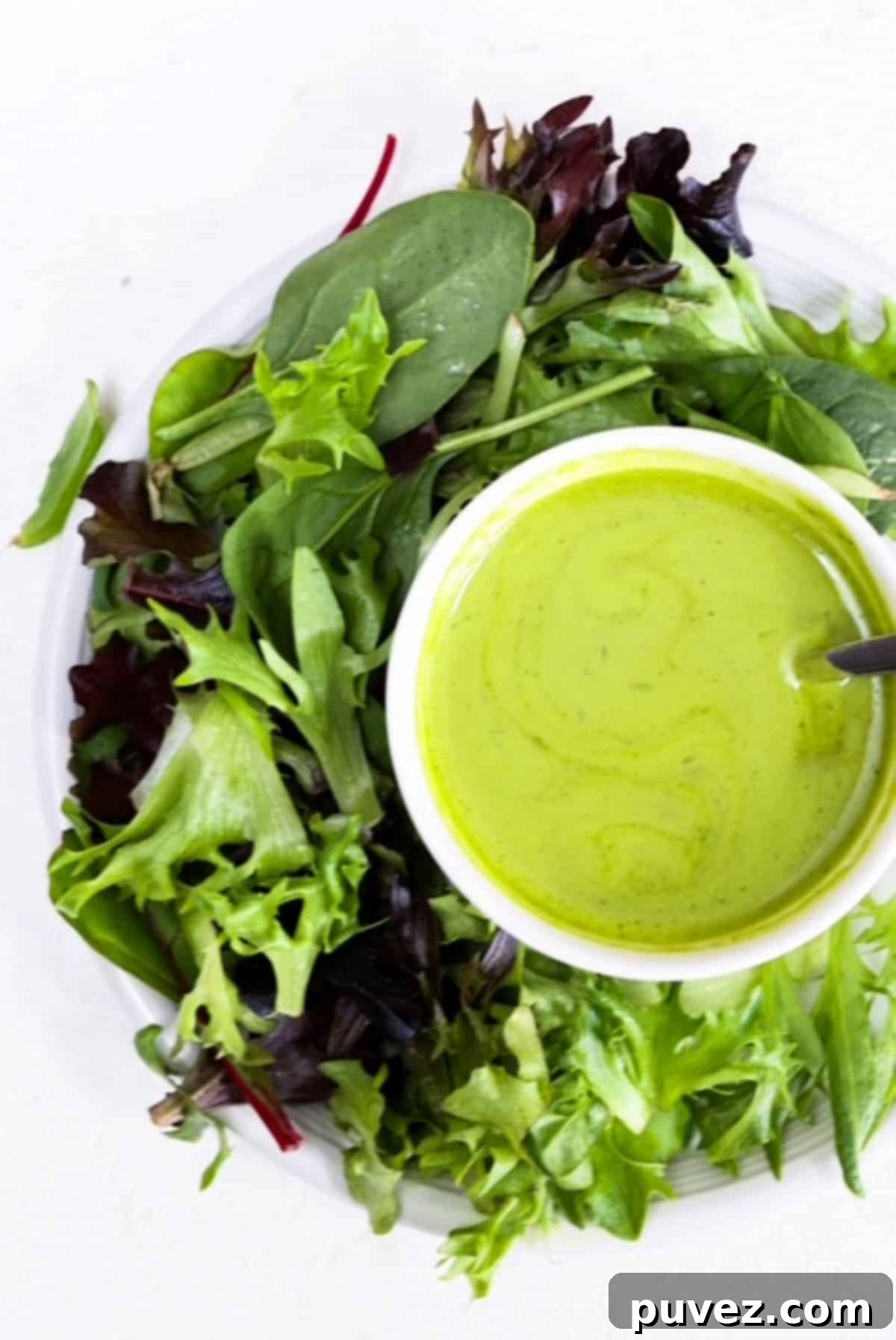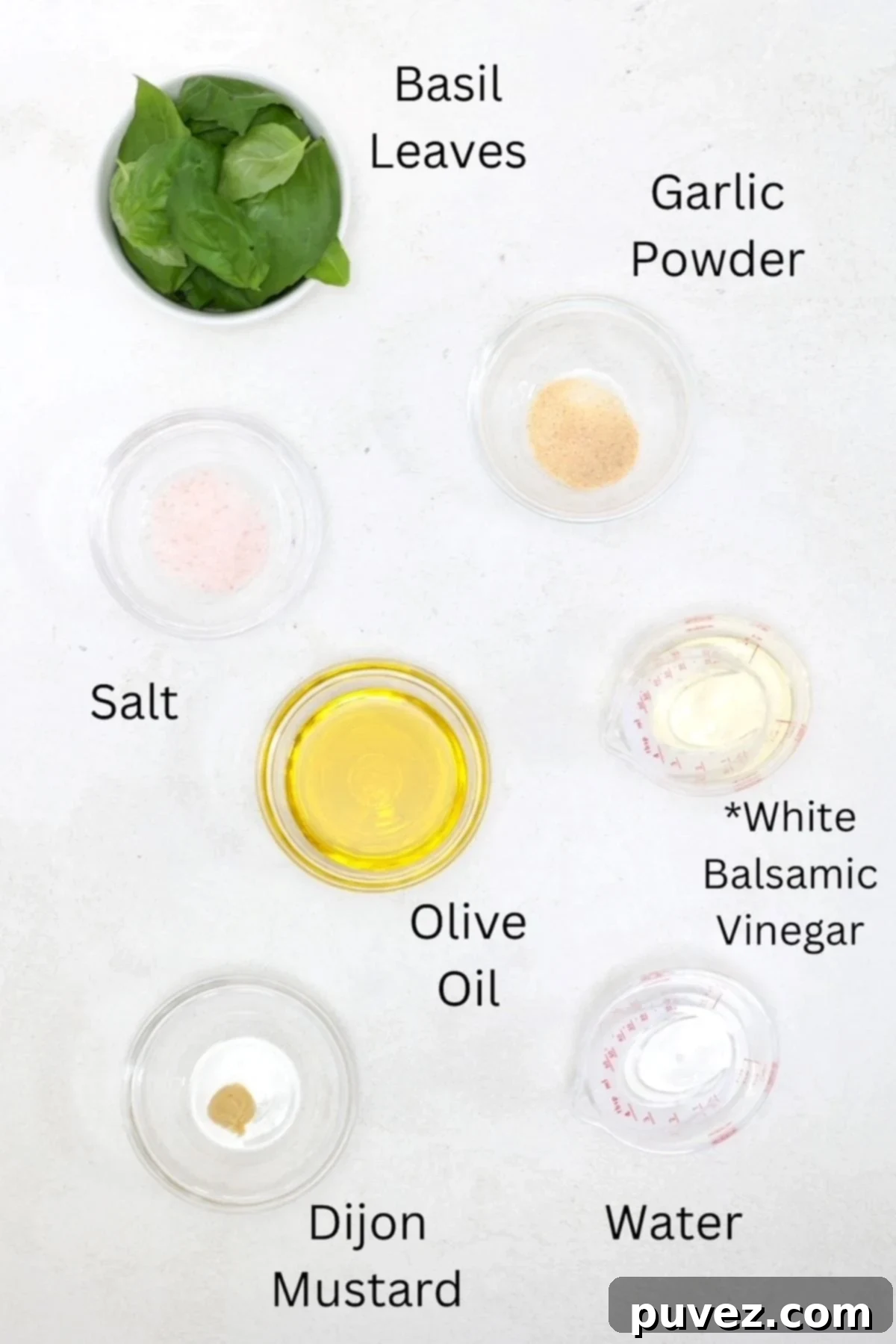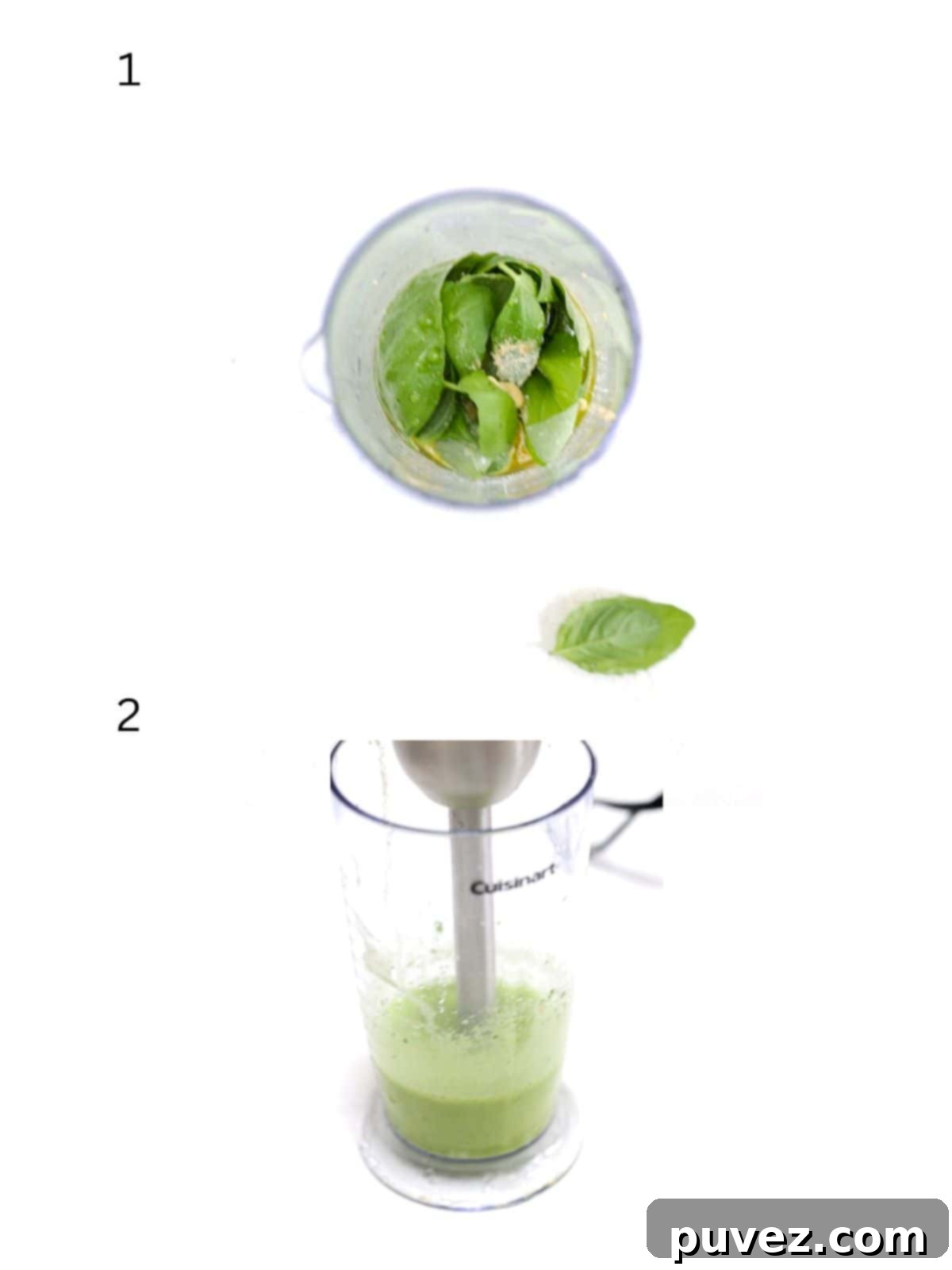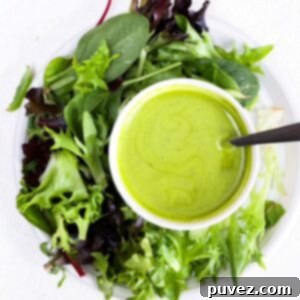Homemade Basil Balsamic Vinaigrette: Easy & Fresh Salad Dressing Recipe
Transform your everyday salads and culinary creations with this vibrant and incredibly simple Basil Balsamic Dressing. Crafted from just a few fresh, wholesome ingredients, this homemade vinaigrette comes together in under 5 minutes, promising a burst of fresh flavor that store-bought versions simply can’t match.

If you’ve never made your own salad dressing before, prepare to be amazed by how incredibly simple and rewarding it is! The secret to truly exceptional flavor often lies in fresh herbs. When you incorporate garden-fresh basil into a basic homemade vinaigrette, it elevates the entire experience to a new culinary dimension.
Fresh basil, in my humble opinion, boasts an unparalleled flavor profile. Its sweet, peppery, and slightly minty notes are distinctive and transformative. Just recall the unforgettable taste of dishes like Caprese bruschetta, the aromatic Margherita flatbread, or a luscious homemade pesto – it’s the fresh basil that consistently takes these recipes from good to truly extraordinary. This basil balsamic dressing is no exception; in fact, it has become my trusted ‘go-to’ recipe, especially when I have an abundance of leftover basil from my garden or a grocery run. It’s a fantastic way to minimize food waste while maximizing flavor! 🙌
One of the beauties of this recipe is its flexibility. You have complete control over the basil intensity. Feel free to adjust the quantity of fresh basil leaves based on your personal preference or how much you have on hand. Whether you prefer a subtle hint or a powerful punch of basil flavor, this dressing allows for perfect customization.
Once you experience the ease and incredible taste of this homemade dressing, it’s highly likely to become a staple in your kitchen, making you question why you ever bought bottled dressings. Get ready to impress yourself and your family with this delightful creation!
[feast_advanced_jump_to]
Why You’ll Love This Homemade Basil Balsamic Vinaigrette
This Basil Balsamic Vinaigrette isn’t just another dressing; it’s a game-changer for anyone looking to add fresh, vibrant flavor to their meals with minimal effort. Here’s why it’s bound to become your new favorite:
- Effortlessly Easy Recipe: Forget complicated steps or lengthy prep. Making this dressing is as simple as adding all the ingredients to a blender or an immersion blender container and blending for about a minute. It’s quick, convenient, and perfect for busy weeknights or impromptu gatherings.
- Unrivaled Fresh Flavor: The difference between fresh herbs and their dried counterparts is monumental, and this recipe truly showcases it. The incredible, aromatic flavors of fresh basil are something you simply cannot replicate with store-bought, pre-bottled dressings. You’ll taste the bright, herbaceous notes that elevate any dish it accompanies.
- Made with Simple, Wholesome Ingredients: You’ll likely find most of what you need already in your pantry. Balsamic vinegar, a good quality extra virgin olive oil, garlic, salt, and black pepper are fundamental pantry staples. Fresh basil is readily available in the produce section of most grocery stores, especially during peak season, making this a healthy and accessible option.
- Versatility at Its Best: This dressing isn’t just for salads! Its balanced flavor profile makes it an excellent marinade for chicken or fish, a fantastic base for pasta salads, or even a delicious drizzle over roasted vegetables. It’s a multi-purpose culinary tool that brings a fresh twist to countless dishes.
- Healthier Choice: By making your dressing at home, you control the quality of ingredients and avoid unwanted additives, preservatives, and excessive sugars often found in commercial dressings. It’s a simple step towards a healthier, more conscious diet.
Key Ingredients for Your Basil Balsamic Dressing

Crafting a truly memorable dressing begins with understanding each ingredient’s role. Here’s a closer look at what goes into this delicious Basil Balsamic Vinaigrette:
- Fresh Basil Leaves: This is the star of the show! Fresh basil provides that signature aromatic, slightly peppery, and sweet flavor that sets this dressing apart. The quantity is flexible; use a smaller amount for a subtle hint or increase it significantly for a more intense basil experience. For the best flavor, choose bright green, unblemished leaves. Remember to wash and dry them thoroughly before blending.
- White Balsamic Vinegar: Also known as white Modena vinegar, this ingredient offers a milder, sweeter, and less intense flavor than traditional dark balsamic vinegar. Its lighter color also ensures your dressing maintains a vibrant green hue from the basil. While I prefer white balsamic for its delicate balance, you can absolutely use regular balsamic vinegar for a deeper, tangier flavor profile, resulting in a darker but equally delicious dressing.
- Dijon Mustard: Even if you’re not a fan of mustard, don’t skip this! A small amount of Dijon mustard plays a crucial role as an emulsifier. It helps to bind the oil and vinegar together, preventing them from separating and creating a smooth, cohesive vinaigrette. It also adds a subtle tangy depth that perfectly balances the flavors without overpowering the basil.
- Extra Virgin Olive Oil: The quality of your olive oil truly matters here. Use a good quality extra virgin olive oil for its rich, fruity notes and health benefits. Olive oil forms the base of the vinaigrette, contributing to its texture and mouthfeel. If you prefer a lighter flavor or have dietary restrictions, avocado oil can be an excellent alternative, offering a neutral taste and healthy fats.
- Garlic: Fresh garlic is key for an authentic homemade taste. One small fresh garlic clove provides a pungent kick that complements the basil and balsamic beautifully. If fresh garlic isn’t available, you can substitute it with about a quarter teaspoon of garlic powder. Adjust to your preference, as garlic can be quite strong.
- Water: A touch of water helps to achieve the perfect pourable consistency, especially if you prefer a lighter dressing. You can adjust the amount based on how thick or thin you like your vinaigrette.
- Salt and Black Pepper: These essential seasonings enhance all the other flavors. Start with a quarter teaspoon of salt and a pinch of black pepper, then taste and adjust. Remember that the final taste can vary depending on the saltiness of other ingredients you might pair the dressing with (e.g., feta cheese in a salad).
How to Craft Your Perfect Basil Balsamic Vinaigrette

Making this Basil Balsamic Vinaigrette is incredibly straightforward, requiring minimal effort and time. Here’s a step-by-step summary to guide you. For the precise measurements and a detailed list of ingredients, please refer to the complete recipe card below.
- Gather Your Tools and Ingredients: First, ensure you have all your ingredients measured out and ready. For blending, you can use a traditional small blender, a food processor, or a tall blender cup that an immersion blender will comfortably fit into. Any of these options will work perfectly to achieve a smooth consistency.
- Combine All Ingredients: Carefully place all of the fresh basil leaves, white balsamic vinegar, extra virgin olive oil, water, Dijon mustard, salt, and garlic into your chosen blending vessel. Make sure the container isn’t overfilled if using an immersion blender, to prevent splashes.
- Blend to Perfection: Secure the lid on your blender or food processor, or position your immersion blender correctly. Begin blending on a low setting and gradually increase the speed. Blend continuously for approximately one minute, or until all the ingredients are thoroughly combined and the basil is finely chopped, creating a smooth, emulsified, and vibrant green dressing. Stop once your desired consistency is reached – some prefer a few tiny flecks of basil, while others prefer it completely smooth.
- Taste and Adjust: Before serving, always taste your dressing! This is your opportunity to make it truly perfect for your palate. You might find it needs a little more salt, a touch more pepper, or perhaps a hint of sweetness (see helpful tips below for adding honey or maple syrup). Adjust as needed, blend briefly again, and you’re ready to enjoy your fresh, homemade vinaigrette!
That’s all there is to it! In just a few minutes, you’ll have a beautifully balanced and incredibly flavorful dressing that’s far superior to anything you can buy.
Creative Ways to Use Your Basil Balsamic Dressing
This Basil Balsamic Vinaigrette is incredibly versatile and can elevate a wide array of dishes beyond just a simple green salad. Its fresh, tangy, and herbaceous profile makes it a fantastic addition to many culinary creations:
- Simple Lettuce Salad: This is its most classic use, and for good reason! A simple salad often goes underrated as a side dish for family meals. Just take a bowl of your favorite salad greens – think crisp romaine, delicate butter lettuce, or a spring mix – and drizzle generously with this dressing. Enhance it further by adding a few cherry tomatoes, sliced cucumbers, bell peppers, or even some toasted nuts like pine nuts or walnuts for added texture and nutrition. For a more substantial salad, consider adding grilled chicken or chickpeas.
- Flavorful Chicken Marinade: Just like a classic Italian dressing, this basil balsamic vinaigrette makes an absolutely phenomenal marinade. The vinegar and olive oil help to tenderize poultry, while the basil, garlic, and Dijon infuse it with incredible flavor. Simply place chicken breasts, thighs, or tenderloins in a shallow dish or a resealable bag, pour the dressing over, and marinate for at least 30 minutes, or up to 4 hours in the refrigerator. Then, grill, bake, or pan-fry for juicy, flavorful chicken. I’m actually marinating chicken breast tenderloins in this dressing as I type this – it’s that good! Yum!
- Delicious Pasta Salad: Bring a Mediterranean flair to your next potluck or picnic with a pasta salad featuring this vinaigrette. Toss cooked and cooled pasta (such as penne, rotini, or farfalle) with a generous amount of this basil balsamic dressing. Add crumbled feta cheese or small chunks of fresh mozzarella, sliced cucumbers, halved cherry tomatoes, and perhaps some Kalamata olives or diced red onion for even more vibrant flavor and texture. This makes for a refreshing and satisfying meal or side.
- Drizzle Over Roasted Vegetables: Enhance the natural sweetness of roasted vegetables like asparagus, zucchini, bell peppers, or cherry tomatoes with a light drizzle of this dressing after they come out of the oven. The fresh basil brightens the earthy flavors beautifully.
- Caprese Skewers or Salad: For a simple yet elegant appetizer, thread cherry tomatoes, fresh mozzarella balls (bocconcini), and basil leaves onto skewers. Drizzle with the vinaigrette right before serving. It also works wonderfully over a traditional Caprese salad of sliced tomatoes, mozzarella, and basil.
- Grain Bowls: Elevate your favorite grain bowls (quinoa, farro, brown rice) by using this dressing as a flavorful base. Combine with roasted vegetables, a protein of choice (chicken, tofu, or legumes), and fresh greens for a complete and wholesome meal.
Dietitian’s Insight: Encouraging Healthy Eating Habits
As a dietitian, I often recommend a simple yet effective strategy to foster healthier eating habits, especially for children: offer choices. When you serve a simple salad as a side dish with dinner, try presenting a selection of salad dressings. This approach offers multiple benefits:
- Empowerment and Autonomy: Giving children options, even small ones like choosing their dressing, helps them feel more involved and in control of their meal. This sense of autonomy can significantly reduce resistance to trying new foods, as they feel they have a “say” in what’s on their plate.
- Increased Exposure to New Foods: Without the pressure to eat something they might initially deem unfamiliar or unappealing, kids are often more open to exploring different flavors and textures. By allowing them to choose a dressing they prefer, you’re gently introducing them to salad in a positive way, increasing the likelihood they’ll eventually try the greens themselves.
- Positive Mealtime Experiences: Mealtimes should be enjoyable, not a battleground. When children feel heard and respected, it creates a more positive and relaxed atmosphere at the dinner table, which is crucial for healthy development and lifelong eating habits.
- Developing Palate and Preferences: This strategy also helps children develop their own palate and identify what flavors they enjoy. Over time, they might even surprise you by choosing dressings with more complex or less sweet profiles.
So, next time you serve a fresh green salad, consider putting out this delicious Basil Balsamic Dressing alongside another option. You might be pleasantly surprised by the positive impact it has on your family’s eating adventures!
Helpful Tips for the Best Basil Balsamic Vinaigrette
To ensure your homemade basil balsamic dressing is always perfect and lasts longer, keep these helpful tips in mind:
- Balancing Sweetness and Tang: Balsamic vinegar can sometimes be quite tangy. If you find your dressing a little too sharp for your liking, consider adding a small amount of sweetener. A teaspoon of honey or maple syrup can beautifully balance out the acidity and enhance the overall flavor profile. Start with just a half teaspoon, blend, taste, and add more if desired. A little goes a long way!
- Optimal Storage: Due to the fresh basil, which can spoil faster than other ingredients, it’s crucial to store any leftover dressing properly. Transfer it to a clean glass jar or an airtight container with a tight-fitting lid. A mason jar is an ideal choice for salad dressings. Store it in the refrigerator. While some homemade vinaigrettes without fresh ingredients can be stored at room temperature, the basil makes refrigeration essential to maintain freshness and prevent spoilage.
- Shelf Life: When stored correctly in the refrigerator, this homemade basil balsamic dressing will typically remain fresh and flavorful for about 5-7 days. Always check for any off-smells or signs of spoilage before using.
- Shake Before Serving: As with most homemade vinaigrettes, some natural separation of ingredients (especially the oil and vinegar) can occur during storage, even with the emulsifying power of Dijon mustard. Before drizzling it onto your favorite salad greens or using it as a marinade, always give the dressing a good, vigorous shake to re-emulsify and ensure all flavors are evenly distributed.
- Adjusting Consistency: If you prefer a thinner dressing, you can add an extra tablespoon or two of water. For a richer, thicker consistency, replace the water with more olive oil, or reduce the amount of water altogether.
- Taste as You Go: This is a golden rule in cooking! Always taste your dressing before finalizing it. Palates vary, and you might prefer a little more salt, pepper, garlic, or basil. Don’t be afraid to adjust seasonings to suit your personal taste.
- Using Fresh Herbs: While dried basil can be used in a pinch, it won’t yield the same vibrant, fresh flavor. For the best results, always opt for fresh basil leaves.
Frequently Asked Questions About Basil Balsamic Dressing
I’ve learned from experience that estimating the amount of oil and vinegar when making a vinaigrette is the biggest mistake. While it might seem intuitive to eyeball quantities, the precise ratio of oil to acid (typically 3:1 oil to vinegar, but varies by recipe) is crucial for a balanced flavor and proper emulsion. Always measure your oil and vinegar accurately, especially when trying a new recipe.
Another common mistake is leaving out the mustard. Many people, myself included, used to skip mustard if they didn’t like its strong flavor. However, mustard (specifically Dijon) is a natural emulsifier. It contains compounds that help oil and vinegar, which naturally separate, to form a stable, creamy mixture. Without it, your vinaigrette will quickly separate into distinct layers of oil and vinegar. Even a small amount of Dijon will do the trick without imparting a strong mustard taste to the final dressing.
Fresh basil can be quite delicate and typically lasts only 1-3 days in the fridge if not stored correctly. To extend its shelf life, treat it like a bouquet of flowers: trim the stems and place the basil bunch in a glass of water, then cover the leaves loosely with a plastic bag (like a produce bag) and store it on your kitchen counter at room temperature, out of direct sunlight. This method can keep basil fresh for up to a week. If storing in the fridge, wrap unwashed basil leaves in a damp paper towel and place them in a sealed container or plastic bag.
When basil is not in season, I often opt for hydroponic basil plants from the grocery store. As long as I keep the plant watered and place it in a spot where it receives adequate sunlight, it can last for several days, providing fresh leaves as needed.
Yes, absolutely. All fresh herbs, including basil, should be thoroughly rinsed under cold running water before you plan to use them. This helps remove any dirt, dust, pesticides, or tiny insects that might be clinging to the leaves. After rinsing, gently pat the basil dry with a clean paper towel or use a salad spinner. Excess moisture can dilute your dressing and even cause the basil to brown faster, so ensuring it’s dry is an important step.
While you technically *can* use dried basil, it’s highly recommended to use fresh for this recipe. Dried basil has a much more concentrated, earthy, and sometimes slightly bitter flavor compared to the vibrant, sweet, and aromatic notes of fresh basil. If you must use dried, start with a much smaller amount (around 1 teaspoon for every 1/4 cup of fresh) and taste as you go, adjusting as needed. The final dressing will have a different, less bright flavor profile.
Yes, this Basil Balsamic Dressing recipe is naturally vegan and gluten-free, assuming all your individual ingredients (like balsamic vinegar and Dijon mustard) are also certified as such. Always check labels if you have strict dietary requirements, but the core ingredients are plant-based and contain no gluten.
Discover More Delicious Homemade Dressings
If you loved this Basil Balsamic Vinaigrette, you’re in for a treat! Explore some of my other favorite easy-to-make salad dressings that will add a burst of flavor to any meal:
- Homemade Caesar Dressing: A creamy, classic favorite made healthier at home.
- Healthy Strawberry Vinaigrette: Sweet and tangy, perfect for summer salads.
- Easy Mango Dressing: A tropical delight that brightens up any green or fruit salad.
- Apple Cider Vinaigrette: A versatile and zesty dressing that’s great year-round.
- Lemon Garlic Salad Dressing: A bright and aromatic staple that pairs well with almost anything.
Easy & Fresh Salad Recipes to Enjoy
Now that you have your perfect basil balsamic dressing, here are some fantastic salad recipes to put it to good use:
- Easy Kale (Tuscan) Salad
- Best Chicken Caesar Salad (Homemade!)
- Easy Strawberry Goat Cheese Salad
- Easy Cold Asparagus Salad
📖 Recipe: Fresh Basil Balsamic Vinaigrette

Basil Balsamic Dressing
Kristi
Pin Recipe
Equipment
-
1 immersion blender or small blender or food processor
Ingredients
- 1 cup fresh basil leaves loosely packed
- ¼ cup white balsamic vinegar can use regular balsamic vinegar for a darker, richer flavor.
- 3 tablespoons extra virgin olive oil or avocado oil for a milder taste
- 2 tablespoons water adjust for desired consistency
- ¼ teaspoon Dijon mustard acts as an emulsifier
- ¼ teaspoon salt or to taste
- Pinch of black pepper freshly ground preferred
- 1 small garlic clove minced, or ¼ teaspoon garlic powder
Instructions
-
Add all listed ingredients – fresh basil leaves, white balsamic vinegar, olive oil, water, Dijon mustard, salt, black pepper, and garlic – into a small blender, food processor, or a container suitable for an immersion blender.1 cup fresh basil leaves,
¼ cup white balsamic vinegar,
3 tablespoons extra virgin olive oil,
2 tablespoons water,
¼ teaspoon Dijon mustard,
¼ teaspoon salt,
Pinch of black pepper,
1 small garlic clove -
Blend for approximately one minute, or until all ingredients are fully combined and the basil is finely incorporated. Continue blending until your desired consistency is reached – whether you prefer a perfectly smooth texture or a slightly chunkier dressing with small flecks of basil.
-
Taste and adjust seasonings as needed. If too tart, add a touch of honey or maple syrup (start with ½ tsp). If too thick, add a bit more water.
Notes
- Basil Measurement: One cup of loosely packed fresh basil typically equates to about 21-28 individual basil leaves, depending on their size. Yes, I sometimes count them to be precise!
- Basil Flavor Intensity: I experimented with various amounts of fresh basil. The distinctive basil flavor truly began to shine when approximately three-quarters of a cup was added, and it became wonderfully prominent when I used a full cup of fresh basil leaves. Adjust to your personal preference!
- Dressing Consistency: This recipe yields a relatively thin salad dressing. If you prefer your salad dressings to have more body and substance, you can replace the two tablespoons of water with an equal amount of extra virgin olive oil for a richer texture.
- Salt Adjustment: If you’re adding this dressing to a salad that already contains salty ingredients, such as feta cheese, you may need to reduce the amount of salt in the dressing itself. Always taste and adjust accordingly.
- Marinade Usage: When using this vinaigrette as a chicken marinade, remember that you’ll be baking or grilling the chicken. It’s a good idea to add an extra pinch of salt and black pepper directly to the chicken before cooking to ensure it’s well-seasoned throughout.
- Optional Sweetener: For a slightly sweeter dressing that beautifully balances the tanginess of the balsamic, consider adding ½ to 1 teaspoon of honey or maple syrup to the blender with the other ingredients.
Nutrition
